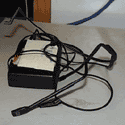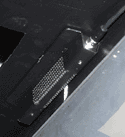Microphones
There are a lot of microphones out there, how do you tell them apart?
First off, we have the pickup pattern. We're talking which directions the mic picks up the most sound. Some common patterns are omni-directional, cardioid, and unidirectional (shotgun). Each pattern in the above list is more focused than the previous. So, a shotgun has the "tightest" pattern. It picks up a very narrow cone of sound, and an omni records sound in a sphere- all areas equally loud.
Some professional grade microphones use something called "Phantom Power" this means the mic requires external power to operate (somewhere between 12 and 48 volts.) If you are using this type of mic, you MUST connect them to a phantom power providing device. All the mixers in our lab can send phantom power, in addition to the portable DAT recorder.
Next, we have the microphone type. At EVL, you can find a shotgun, condenser, PZM, wireless headset, even some lavalier clip ons.
For VR audio setups, we've been using 2 mics, a headset (the VEGA Wireless) and the Crown PZM for ambient sounds.

VEGA wireless transmitter

Crown PZM mic
| The
Shotgun: lives in the portable DAT case, it is useful for video taping, and other situations where you need to get a sound from a distance, and you want to ignore other ambient sounds. |
Condesor: These are very delicate, and should be handled with care. We have a matched pair of Sure SM-81s (also in the DAT case) they record with a cardioid pattern, and sound great. |
PZM: Also know as "paddle mics", they are used to capture ambient sounds. We use them on our I-desks so we can hear people talking who aren't on a headset mic. |
VEGA |
Lavalier This clip-on lives behind the edit suite in a Sony case. This type of mic is good for interviews, it picks up the wearer well, and a little ambiance. |
Speakers
Mainly we use Genelec self powered speakers for our systems at EVL. These
"near field monitors" are designed to amplify a signal and send
it out straight to your ears, thus reducing the background noises. Designed
for a recording studio environment, the sound quality is top notch, plus
they are pretty rugged. Since they are self powered, you don't need an
amplifier to use them. Also note, since these are professional grade products,
they take a balanced line input.
In the CAVE, we also use a subwoofer (located behind the right wall) to
fatten up the low end. At one point, Joe Reitzer built a special floor
(for the now defunct Power Wall) which was loaded with special sub-bass
speakers. This floor could vibrate you and let you feel the music in a
whole new way. If you are interested in the "Thunder Floor"
please contact Joe from the EVL web page.

Powered monitor speaker
We have two DAT recorders, one portable (the Tascam DA-P1) and one rack mount (in the edit suite). They both have analogue and digital i/o, and the Tascam has phantom power as well.
The Panasonic is wired into both the mixing board, and the digital input of the AVID. Both machines record time code, but neither have RS-232 controls. Once again, if you are confused about the connectors used on any of these pieces of gear, check the connectors page.

Tascam DA-P1

Panasonic SV-3800